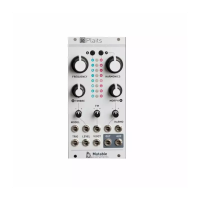on step 6, 11 and 15 to remind you that the step sequence 1 “cycles” over 5 steps only.
Trivia: the longest non-repeating pattern you can build with Ambika is 20677 steps long (set sequence
1 to 23 steps ; sequence 2 to 29 steps ; and the note sequence to 31 steps). With a clock speed of
of 86, the sequence would last for 1 hour!
These settings are not related to a specific part. They are saved (along with each part’s individual
Bpm 120|groo swin|amnt 0|ltch 0
is the master tempo, in beats per minute. Use
: groove template. The options are
(uneven distribution of pairs of 1/8th notes),
(uneven distribution of pairs of 1/16th notes),
(humanization + shuffle). This setting only has an effect when
is set to a non-zero value.
: amount of groove to apply.
: clock latch release time. This parameter controls the number of beats during which the
internal clock continues running after you have released all keys. This allows the internal arpeggiator
or sequencer to “keep counting” for a while after you have released all keys from the keyboard. When
this setting is set to 0 and the arpeggiator is
, every time you release the keys to play a new chord,
the internal clock stops and the arpeggiator/sequencer is restarted. You might like this effect (many
vintage synths work this way), but it might sound a bit strange to have the “flow” of the sequence
broken at each chord change. When the clock latch is set to 1 beat, the “flow” of the clock and
arpeggiator are preserved as long as your chord changes are spaced by less than 1 beat.
Para 0|freq 96|para 0|freq 96
env2 27|volu 120|env2 24|volu 120
Ambika – User manual | Mutable Instruments http://mutable-instruments.net/ambika/manual
30 of 44 2/17/17 4:58 PM

